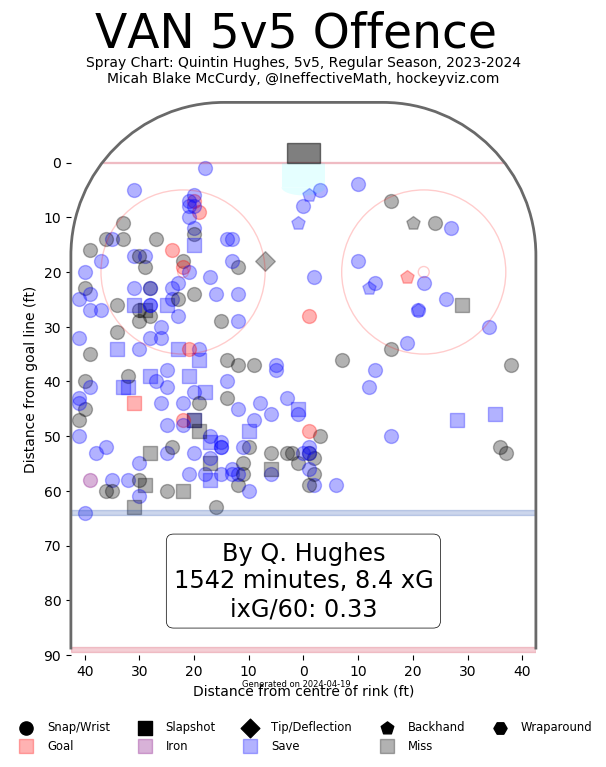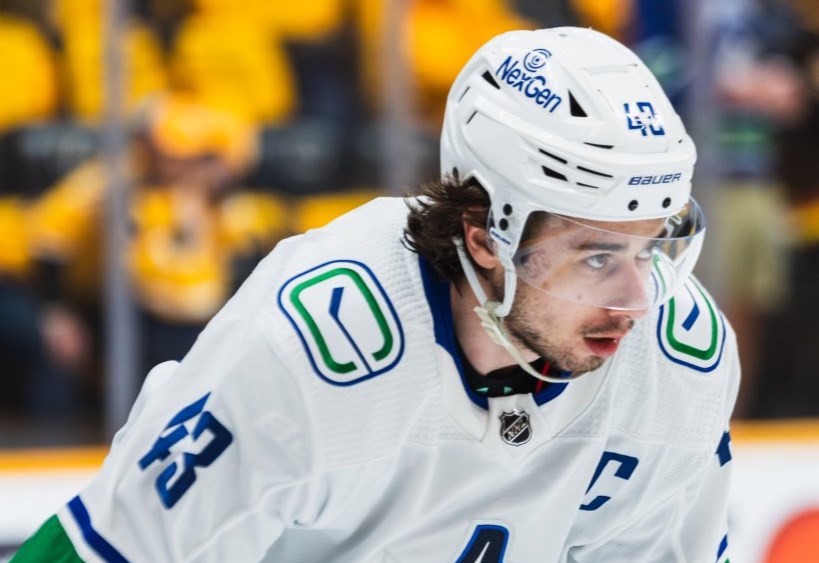17 goals. 92 points. The first-ever Norris Trophy by a Vancouver Canucks defenceman.
Quinn Hughes was outstanding in the 2023-24 season and it was in the conversation for the best season by any Canuck in franchise history.
It wasn’t just the goals and points for Hughes but how he dictated play for the Canucks every time he stepped on the ice. He led the Canucks in corsi and goal differential at 5-on-5, all while playing more minutes against elite competition than any other Canucks defenceman. The ice was heavily tilted in the Canucks' favour every time he stepped over the boards.
It felt like the kind of season that might be the pinnacle of a player’s career but Quinn Hughes is still just 24 years old. Is it possible that he can be even better in the 2024-25 season?
Hughes seems to think so, as he’s setting his sights on setting another career-high.
“I think I can get to the 20-goal mark, hopefully,” said Hughes on Monday at the Canucks’ Jake Milford charity golf tournament. “I think we have a really good team and a great power play, and I know I'm going to get the looks where I can do that, it's just about capitalizing.”
Last season, Hughes more than doubled his previous career high in goals, which didn’t happen by accident. It was the end result of a lot of intense, intentional work in the previous offseason.
Hughes became a far more dangerous goal-scoring threat
For many NHL players, the offseason is about regaining muscle mass lost in the previous season and working on the physical aspects of their game: strength, conditioning, speed, and explosive power, as well as skills that don’t require a game situation, such as skating and shooting the puck.
Hughes, however, can be compared to the Sedins in how he approaches the offseason. Daniel and Henrik would obviously work on those same physical elements but would also always come back from the summer with new wrinkles to their game and new tricks up their sleeves. They didn’t just look to get stronger or faster but worked on adding layers to their games, knowing that opposing players and coaches were studying their game tape and game-planning how to stop them.
Last offseason, Hughes broke down what he needed to do to go from a 70-point player to a 90-point player — he needed to become more of a goalscoring threat. He could have tried to address this need simply by improving his shot but he realized what he really needed was to improve where those shots came from. He worked with performance coach Darryl Belfry to figure out how to more consistently get to scoring areas on the ice by manipulating his opponents with his skating.
It worked. Hughes was a menace in the offensive zone and was able to find ways to jump up from the blue line and get into the left faceoff circle for more and better chances. His improved shot helped but the increase in scoring chances helped a lot more.
According to Natural Stat Trick, Hughes’ previous career-high in scoring chances at 5-on-5 was 69 in 2022-23. Last season, he had 111. Only one defenceman had more: Roman Josi with 132.
On the power play, Hughes had 28 scoring chances in the 2022-23 season. Last season, he improved that to 43, which was third among defencemen behind Josi and Cale Makar, who both had 54.
Those are huge jumps. Hughes took more shots last season from more dangerous areas on the ice and the result was inevitable: a leap ahead in goalscoring.
It’s unlikely that Hughes can take a similar leap next season but can he make incremental improvements to be even better?
Hughes could be even less predictable with the puck this season
Hughes' ability to attack the heels of opposing forwards allowed him to jump up the left side for scoring chances but, in this coming season, teams are going to anticipate that left-side attack. That's likely why he spent the offseason working on a way to make himself even less predictable at the blue line when he has the puck.
“Just, like, not only being able to come down on my forehand [but also] being comfortable on my backhand on the other side,” said Hughes. “Worked a little bit on that this year and I think you should be able to see more of that.”
The benefit of being better on his backhand coming down the right side of the ice is clear: if opposing teams start to cheat toward his left side to cut off his attack, he can simply shift to the other side of the ice to create scoring chances on the right.
Being equally threatening on both sides of the ice could, in theory, make him even more of a nightmare to defend than he already is. Last season, as much as he created far more chances for himself, they were primarily at the left faceoff circle; if more of those chances come from the right side, what is the defending team supposed to do to stop him?

With that in mind, 20 goals seems easily within reach for Hughes. After all, he scored 17 goals last season — three more goals could just be a few bounces away.
Will regression come for Quinn Hughes?
Scoring 20 goals won’t be easy, however. In the last ten seasons, just 13 defencemen have scored 20+ goals in a season. It’s a difficult mark to reach but Hughes took some inspiration from a defenceman who’s done it twice: Roman Josi.
“[Josi] was able to come down and skate with us in Michigan two weeks ago, so I was able to kind of pick his brain,” said Hughes. “He’s been one of the best players of this generation.”
The other thing to consider is how much of Hughes’ scoring boost last season came from luck being on his side. His 8.5% shooting percentage was a new career high, well above his career average of 5.9%. Likewise, his on-ice shooting percentage — his team’s shooting percentage when he was on the ice at 5-on-5 — was another career-high at 12.1%.
Hughes, however, made his own luck last season. His increased shooting percentage was much more a reflection of creating better scoring chances than an unsustainable bout of shooting luck. His shots consistently came from a lot closer to the net than in previous seasons — of course, his shooting percentage improved.
His shooting percentage wasn’t even that outrageously high. Among NHL defencemen with at least 500 minutes at 5-on-5, Hughes ranked 35th in 5-on-5 shooting percentage at 7.19%.
Many of Hughes’ contemporaries among number-one, Norris-caliber defencemen had higher shooting percentages last season. Adam Fox had a 10.34% shooting percentage at 5-on-5, Charlie McAvoy was at 9.28%, Cale Makar shot 8.09%, and Victor Hedman shot 7.34%.
In other words, Hughes’ shooting percentage last season was right in line with the other elite defencemen in the NHL. In fact, there’s arguably room for improvement. At the very least, if Hughes can continue to get dangerous scoring areas on the ice, there’s little reason to believe that his shooting percentage will regress to his previous career average.
"I don't think my goal is necessarily the Norris"
If Hughes can be even better in the coming season, could that mean another Norris-worthy season?
That would be a lot to ask from the Canucks captain. The last player to win back-to-back Norris Trophies was Nicklas Lidstrom, who won the award six times in a seven-year span in the early 2000’s.
In any case, Hughes isn’t setting his sights on the Norris.
“I don't think my goal is necessarily the Norris. My goal is the process,” said Hughes. “If I'm competing and playing the way and attacking the way I want to every game, good things will happen.”
That process isn’t just about what happens on the ice but in how he prepares off the ice.
“I played 98 games last year, I didn't miss a game,” said Hughes. “I have the format of what I need to be successful, how you need to sleep and eat and train — I have the blueprint. And now I’ve just got to continue to do it and then try to build on my game and what I can do better.”
One of those areas where he hopes to improve is his playoff performance. It’s not that he had a bad playoffs but he was frustrated that he didn’t find the back of the net — all ten of his points were assists.
“In the playoffs…I didn't hate my game, I liked my game, but it would have been nice to score a goal, or change the direction of a game when I needed to,” he said. “And that's something that I focused on this summer, and we'll see if I can do it this year.”
And, as much as he’s focused on process, the Norris isn’t entirely out of his mind. Hughes at least wants to be in the conversation for the award, as that would be a sign that he’s accomplishing his true goal.
“Consistency is the sign of a great player,” he said. “I was reading that pamphlet at the awards, and Makar has been up for [the Norris] four of the last five years…That's consistency.”



